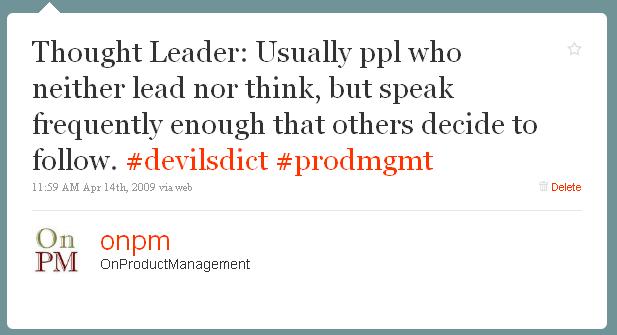Last year, as I was creating content for my Devil’s Dictionary for High Tech – I tweeted the following:
You can see the original Tweet here.
Now this was clearly a satirical definition, but it is based on my experience with the topic of thought leadership. I’ve been in more than a few meetings where someone stated that one of the marketing goals was to be seen as a thought leader in our space in the coming year.
No one, myself included, asked what it actually meant to be a thought leader, or how we’d know that we’d achieved our goal, or even what the benefits were if we did become one. The goal of being seen as a “thought leader” was in itself a phrase whose meaning seemed self-evident.
But, clearly that isn’t the case. As mentioned in a previous post, Tom Grant at Forrester is conducting research on thought leadership and is looking for community input.
Having said that, I thought I’d get some direct input from you folks about this topic. And while Tom is focusing on thought leadership in the enterprise software and services space — using Salesforce.com and Wipro as case studies — I see this topic having direct relevance to Product Management.
What is a thought leader?
Before going further, let me try to put a box around the phrase “thought leader”. I say “try”, because I think the phrase will mean different things to different people and there is no single definition that can cover all viewpoints. Here’s one view:
A thought leader is someone who consistently communicates credible and unbiased information and insight in a particular domain AND whose insights are used by others to take action or make decisions about issues in that domain.
OK, so that won’t fit into a single tweet, and it probably could use improvement (your thoughts are welcome), but it does contain several important points.
1. Thought leaders are people.
Yes, sometimes an organization can be viewed as a thought leader, but it’s the people who make up the organization, and in particular those who speak for it, and represent it that can be viewed as thought leaders.
2. Thought leadership is an active task.
People must communicate in an ongoing manner. A brilliant person who cannot communicate his/her insights to a wide audience cannot be a leader. Communication is one of the 4 Cs of Leadership.
3. Credibility and trust are a must
Virtually anyone can speak on any topic, and with web technologies, they have a virtual megaphone to get their message across. But that fact alone doesn’t make someone a leader. Thought leadership, like any type of leadership requires the trust of those who follow. The leader must be believable and not be seen as a self-promoter or a shill for some organization.
4. Other people/parties must find the leaders insight relevant and actionable
Leadership must be tied into action or progress for those who follow, and not simply the number of those who will listen.
For example, Kanye West joined Twitter on July 28/2010. He had about 200,000 followers the next day and currently has almost 500,000 (roughly 1 week later). Does that make him a thought leader? Not in my opinion, at least not on Twitter. Between musings on life, or Twitpics of things he wants to buy, it’s hard to see how any of this minutae about his life can be considered useful insight. In fact, Kanye seems like a perfect example of the Devil’s Dictionary definition I gave at the beginning of this post.
Product Managers are thought leaders
Looking at the 4 points above, they can clearly be applied to the role of Product Management. Product Managers must lead through influence, must convince others of their perspectives and views, must have credibility and trust, and must communicate information in ways that others find useful and relevant. This applies to both internal teams and with external audiences.
Product managers may not see themselves explicitly as thought leaders, but they often are viewed that way by others. Keep this in mind as you work through your next research project or product release.
How would you define thought leadership?
Do you see yourself as a thought leader in your company?
Saeed
